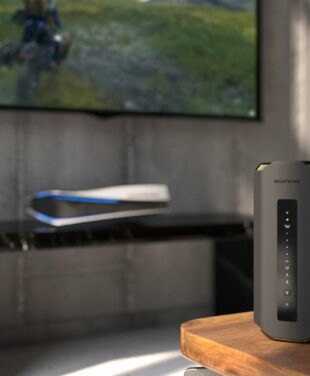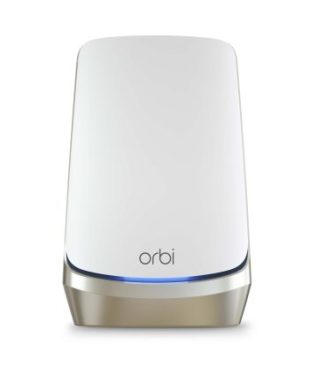Mesh WiFi has taken internet connectivity to a whole new level in homes and businesses around Australia, but where does that leave traditional Ethernet wired connections? Let’s take a look at the different ways mesh WiFi and Ethernet connections can work together for superior internet performance and functionality.
IN THIS ARTICLE
- The Essence of Mesh WiFi and Ethernet Integration
- Ethernet Passthrough for Smart Homes
- High-Speed Ethernet Backhaul
- Why Consider Ethernet with Mesh WiFi?
- How to Integrate Ethernet with Mesh WiFi
- Considerations for Ethernet and Mesh WiFi Integration
- Satellite Node Daisy Chaining
- Things to Avoid When Setting Up a Mesh WiFi System
- NETGEAR Orbi 970: WiFi Versatility for Today and Tomorrow
- FAQs
The Essence of Mesh WiFi and Ethernet Integration
Mesh WiFi networks are becoming well known for their seamless coverage and robust wireless connection performance. However, the integration of Ethernet with these wireless networks can enhance your overall connectivity experience. The router satellite nodes of the best mesh systems sport multiple Ethernet ports that can be used for dedicated device connections, powerful backhaul performance, and extending home and office networks further than ever, without compromising speed. This page will explore the many ways Ethernet and WiFi can work together for the best of both worlds.
Ethernet Passthrough for Smart Homes
Let’s start with a useful tip for delivering the best WiFi performance in your home. The latest whole-home mesh WiFi systems, such as NETGEAR’s Orbi 970, include multiple Ethernet connections on the main router and on the satellite nodes. By situating a mesh node where you are currently using a wall socket Ethernet connection, the Ethernet ports on your satellite node can function as a simple passthrough.
Ethernet comes in from the wall jack, so whatever device you previously had plugged into the Ethernet jack, such as a TV, laptop, or Windows PC, can be plugged into a satellite node port. This way you don’t need to exclusively use the single wall plug Ethernet connection for the device. Plus, your mesh node is automatically hooked into your home’s mesh network, ready for wirelessly connecting more devices and smart home applications.
High-Speed Ethernet Backhaul
You can use the Ethernet ports on your mesh system router and satellites to connect to your ISP’s modem and individual Ethernet-based devices such as gaming consoles and smart TVs. In addition to invaluable mesh router utility, you can also use the Ethernet port for carrying wired backhaul traffic. This can take the data backhaul workload off your wireless router and mesh nodes, freeing up bandwidth for better wireless device performance. The latest WiFi 7 systems go a long way toward eliminating the need for high-speed Ethernet backhaul, but it still has its uses.
Whether yours is a basic dual-band WiFi configuration or an advanced tri-band system with a dedicated wireless backhaul channel, it’s still subject to things that can impede and limit WiFi performance, such as interference and bandwidth congestion. When you link your mesh nodes back to your base router station via Ethernet, the Ethernet cable connection handles all the backhaul traffic. Older WiFi 5 and WiFi 6 mesh systems in particular will experience a huge performance boost with improved network stability, low latency, and high-speed data transfer rates.
With NETGEAR Orbi, the choices are all yours for linking back to the primary router access point either by WiFi or by a physical Ethernet cable connection. Mesh WiFi with Ethernet backhaul is the best of all worlds.
Why Consider Ethernet with Mesh WiFi?
Every mesh system has at least one router node that has an Ethernet port. Even if the satellite nodes don’t have ports, the main access point router node will use an Ethernet wide-area network port (WAN port) for connecting to your modem and your internet service provider (ISP). It’s worth noting that the latest WiFi 6E and WiFi 7 mesh systems include multiple Ethernet ports on all satellite nodes. For example, NETGEAR Orbi 970 mesh systems:
Main Router – Four 2.5Gbps Ethernet ports, One 10Gbps Ethernet port, One 10Gig Internet port.
Satellite – Two 2.5Gbps Ethernet ports, One 10Gbps Ethernet port
Whole-home mesh WiFi systems haven’t eliminated the need for Ethernet connections. In fact, by working together in synchronised harmony, both wireless connections and Ethernet wired connections are enhanced and improved for total LAN port satisfaction.
Advantages include:
– Stability: Ethernet connections provide a stable and fast connection, ideal for high-bandwidth activities like multi-player gaming and high-definition streaming.
– Reduced Latency: Wired connections can offer lower latency compared to wireless connections, crucial for real-time applications.
– Backhaul Options: Using Ethernet for backhaul (the connection between mesh nodes) can free up wireless bandwidth for up to 200+ devices in concurrent use.
How to Integrate Ethernet with Mesh WiFi
When shopping for a mesh system, it’s important to access the functions you want for your household or office. For instance, if Ethernet passthrough or wireless bridging is on your wish list, be sure to keep an eye out for mesh systems that have multiple Ethernet ports on the satellite nodes. A quick recap of why this is important.
Ethernet Backhaul – Connect your mesh nodes using Ethernet cables. Mesh WiFi with Ethernet backhaul can improve the speed and reliability of the mesh network.
Wired Devices – Connect devices directly to mesh nodes via Ethernet cables. This is particularly beneficial for dedicated stationary devices that require consistent high-speed connections.
Considerations for Ethernet and Mesh WiFi Integration
NETGEAR Orbi can perfectly complement your existing router and take WiFi performance to the next level. The world of WiFi internet is evolving fast, and if your current setup is more than a few years old, or you are someone who wants the latest products on the market, it could be a good idea to upgrade to NETGEAR Orbi quad-band WiFi with a dedicated backhaul channel. However, getting devices off your WiFi network can still improve overall WiFi performance. So, if your satellite node is situated next to a device with Ethernet, plug it in.
The same goes for older devices that don’t work optimally with WiFi. For example, if yours is a not-so-smart smart TV that functions poorly with WiFi, simply plug the TV directly into a satellite node Ethernet port for a better WiFi signal. Considerations include:
Cabling Requirements – You’ll need to consider the practicality of running Ethernet cables to your desired locations.
Compatibility – Ensure your mesh system supports Ethernet backhaul and has sufficient Ethernet ports on the nodes.
Satellite Node Daisy Chaining
WiFi router throughput performance has dramatically improved during the past decade, but Ethernet is still the connection of choice for many internet users. The good news is that modern WiFi mesh systems support satellite node daisy chaining. This means that satellite nodes can be linked to the main access router and other satellite nodes using Ethernet cables. Although this approach might appear messy in your average home, it can be perfect for larger establishments where Ethernet cabling can be run discreetly in the roof cavity and along rafters and beams. Simply daisy chain Ethernet cable from one node to the next.
The best WiFi mesh systems of today include three or more bands, with one band dedicated exclusively for backhaul communication. A typical tri-band WiFi configuration has one 2.4GHz band and one 5GHz band for fronthaul use, and a separate band for backhaul use. In addition to shared and dedicated wireless backhauls, many mesh systems support the use of Ethernet as a dedicated high-speed wired backhaul.
NETGEAR Orbi mesh systems include Gigabit Ethernet ports as a standard feature, making Ethernet backhaul a useful daisy-chaining feature for taking full advantage of the additional bandwidth. Regardless of whether your system is dual-band with a shared wireless backhaul or tri-band/quad-band with a dedicated backhaul, you still can’t beat the stability and speed of Ethernet for the best of both worlds.
Things to Avoid When Setting Up a Mesh WiFi System
Competition in the WiFi world is strong, with new products introduced regularly. The latest WiFi 7 standard offers dramatic networking improvements that give business owners, gamers, educators, engineers, technologists, and networkers a significant advantage, and there is a real buzz around the industry. From whole-home WiFi mesh to optimised WiFi extenders and unlimited smart home applications, the benefits of WiFi are here today for a future-proofed tomorrow. Here are eight important tips to ensure the WiFi system you buy is the right one for you.
Don’t Buy the Wrong System For Your Household
When mesh WiFi for home use was launched a few years ago, there were only a couple of options. Today there are dozens of options that can be bewildering for those of us who aren’t tech savvy. So how do you choose the right WiFi mesh system for your home? A good start is the square footage rating. A NETGEAR Orbi 970 3-Pack mesh system, for example, can deliver 10,000 sq. ft. of seamless WiFi coverage. You can always add another satellite node at a later date if you need more coverage.
Consider Dedicated Backhaul WiFi Mesh For Big Homes
While the smallest mesh satellite access points look cool, they can suffer from performance issues due to the smaller antennas. Choose a system with the capacity for dedicated backhaul communication between access points, especially if you have a larger home. NETGEAR Orbi products include this dedicated channel. These dedicated backhaul systems work better if you have to jump to more than one access point from the main router to reach a device.
Choose Satellite Placement for Better Performance
The placement of your main router and satellite WiFi access points can be the difference between blazing-fast coverage and a slow signal. Experiment with different node locations and do a speed test to ensure your system is optimally configured. Orbi satellite nodes are attractive decor pieces and also include beamforming so you can target specific devices to improve internet speeds and eliminate WiFi dead zones around your home.
Start in the Centre of Your Home if Possible
Place your main access point router and modem toward the centre of your home if possible. This will ensure you need to install fewer satellites between the router and your devices. A star-layout WiFi node formation can be ideal. With the right arrangement, everyone under one roof can have their own networking space with superfast connection speeds.
Place Access Points Where There Is a Strong Signal
Ideally, each satellite should be spaced about 9 metres (30 feet) apart. Place the satellites between areas with a good signal and in open areas away from walls and obstructions where possible. With the right arrangement, you will be able to achieve a strong WiFi mesh network connection upstairs, downstairs, and even out in the backyard.
Avoid Placing Satellite Nodes in Enclosed Spaces
Place your satellite nodes out in the open and high up for best results. Orbi satellites are more than just WiFi connections; they are attractive decor pieces worth showing off. Orbi satellites look great on tables, stands, and mantle shelves.
Consider Your Existing Ethernet Wiring
Even the best mesh WiFi systems can struggle to compete with the reliability of Ethernet cables. If your home has existing Ethernet cables installed, you can use that infrastructure to create a dedicated wired backhaul system for connecting satellite access points.
Don’t Buy an Outdated WiFi System
Now that WiFi 6, WiFi 6E, and WiFi 7 are widely available, it’s probably time to invest in the future by skipping WiFi 5 systems with outdated firmware. A future-proofed mesh WiFi system will save you money in the long run. With an Orbi WiFi 7 service set identifier (SSID), you can simultaneously have a home network, guest network, and smart home Internet of Things network for applications such as security systems and Amazon Alexa sound systems.
NETGEAR Orbi 970: WiFi Versatility for Today and Tomorrow
You have heard me mention NETGEAR Orbi on this page, and for good reason. NETGEAR Orbi 970 whole-home mesh WiFi delivers exceptional wireless coverage and also supports Ethernet backhaul. With Orbi, you can enjoy the best of both worlds – the convenience of mesh WiFi and the solidity of wired connections, all in one sophisticated package.
Integrating Ethernet with your mesh WiFi network is a smart move for creating an uncompromised, high-performance home network. It combines the extensive coverage of mesh WiFi with the steadfast nature of wired connections. For those with a penchant for top-tier networking solutions, systems like NETGEAR Orbi 970 offer an elegant, powerful, and versatile approach to home connectivity.
FAQs
Does using Ethernet with mesh WiFi improve speed?
Yes, it can improve the Mbps or Gbps speed and reliability of your network. The combination of WiFi and Ethernet delivers the best available internet connection performance.
Can I use Ethernet with any mesh system?
While most modern mesh systems support Ethernet, it’s best to check the specs of your particular system. Contact a NETGEAR retailer for more information.
Is setting up Ethernet with mesh WiFi complicated?
It can be straightforward, especially with user-friendly systems like NETGEAR Orbi, which are designed for easy integration. The entire system can be set up in less than half an hour using the handy Orbi app.
Will Ethernet cables affect the aesthetics of my home?
With thoughtful planning, you can maintain the aesthetics of your home while enjoying the benefits of Ethernet connections. Ethernet integration is easy with Orbi WiFi.
What is Power over Ethernet (PoE)?
Power over Ethernet (PoE) is a cutting-edge technology that allows network switches to transmit both internet data and power simultaneously through an Ethernet cable.




